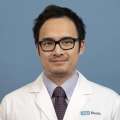A few months ago, Barbara Hardin felt winded carrying a gallon of milk, even with an oxygen tank filling up her emphysema-damaged lungs.
Hardin, 67, could no longer climb a few steps or keep up with her five grandsons because she couldn’t fully expel the used air trapped inside those overly inflated lungs.
“Just breathe. Just breathe. It sounds so simple but it’s not,” Hardin said. “It felt like somebody was holding my nose shut and I was drowning. I was born and raised in California and I couldn’t walk on the beach.”
Since August, she’s been able to breathe easy after undergoing a relatively new minimally invasive procedure called bronchoscopic lung volume reduction, or BLVR, that improves lung function.
Tiny valves are inserted in the lungs to allow overinflated lungs to deflate and get rid of trapped air, offering an alternative to more invasive and risky surgery, according to Dr. Scott Oh, DO, section chief of UCLA Health Interventional Pulmonology.
“If we choose the right patients, they feel and do a lot better with the valves,” Dr. Oh said. “These are patients who basically had no other medical options, they were stuck. This technology and new treatment option really offers something meaningful for a group of patients who remain short of breath despite being treated with every medication available.”
Hardin, who lives in Oxnard, underwent placement of five valves by Tao He, MD, PhD, a UCLA Health interventional pulmonologist, at UCLA Santa Monica Medical Center. The same day, she no longer needed supplemental oxygen.
“It was the easiest thing. It was like having someone put a Band-Aid on my toe,” she said. “I’m still just in the glow of it all. I get teary talking about it. It’s such a gift. It’s a miracle.”
Less expensive, less invasive
Dr. Oh said UCLA is among a handful of medical centers that offer BLVR within 100 miles. He said patients come from as far as Las Vegas, with about 80% discovering the procedure, which is usually covered by insurance, through their own research.
BLVR is used to treat advanced emphysema, a type of chronic obstructive pulmonary disease (COPD) where damaged air sacs in the lungs cause shortness of breath. In the U.S., emphysema is primarily caused by smoking and has been diagnosed in about 3 million people.
When the lung is damaged and destroyed, leading to holes in the lungs because of emphysema, the functional area of the lungs shrinks. This makes it harder to breathe in and out, leaving old air trapped and less room for fresh air to enter and send oxygen to the bloodstream. Dr. Oh likened the lungs to a balloon that can inflate but not deflate.

“Your lungs are highly adaptable to the demands of what you’re doing,” Dr. Oh said. “If you’re sitting down watching a movie vs. exercising, the demand put on your breathing is really variable. In people with advanced emphysema, the lungs get so trapped with air, you can only breathe in and out just a little bit at a time. That makes people get really winded with hardly doing anything.”
BLVR works by using valves to block air from entering and overinflating the damaged sections of the lungs, allowing healthier parts of the lungs to take in more air.
“What the one-way valves do is let your breath out but prevents the air from entering the targeted area of the lungs,” Dr. Oh said. “We put the valves strategically in the most diseased parts of the lungs. As you breathe in and out, that diseased area of the lung deflates. As it deflates, we get that real estate back and the remaining lung is able to function better.”
During BLVR, interventional pulmonologists insert anywhere from three to six valves, which are about the size of a kidney bean and made of metal alloy. They use a thin lighted tube, called a bronchoscope, to deliver the valves through the throat and windpipe for placement in the lungs. The procedure takes about 45 minutes to an hour under general anesthesia.
Patients stay in the hospital for a few days afterward, not to recover, but so their lungs can be monitored. Dr. Oh said in the first few days post-procedure, there’s roughly a 25% to 30% chance of lung collapse, which is remedied by inserting a small tube to re-inflate the lungs.
The valves are designed to last a lifetime but the procedure can be reversed. In rare instances, a valve can become malpositioned but it can be removed and replaced.
BLVR, which was approved by the U.S. Food and Drug Administration in 2018, is an alternative to lung transplant and lung volume reduction surgery that requires cutting through the chest to remove part of the lung. Lung volume reduction surgery was first described in the medical literature as early as the 1950s.
“In a certain group of patients, surgical lung volume reduction helps a lot, but it’s a relatively invasive operation to go through, which people understandably prefer to avoid if possible,” Dr. Oh said. “We’ve been trying to find ways to achieve the same benefit in a minimally invasive fashion, without having to do surgery.”
BLVR is not only less risky, it’s less expensive. While there’s not yet data on whether the valves extend lifespans, Dr. Oh said they improve lung function, improve shortness of breath and increase exercise tolerance.
“The data for the valves have not been shown to prolong survival – it’s been shown to improve quality of life and functional status,” Dr. Oh said. “People go from being very short of breath and very limited in their activities, to a functional status where they can go out and do everyday things they couldn’t do previously.”

Dr. Oh said patients who may not qualify for the procedure can be evaluated for other treatment options for COPD including surgical lung volume reduction and lung transplant. Patients are not candidates if their lungs are too healthy or if it’s determined that the lung anatomy will allow air to sneak into the targeted area so that the valves won’t work.
He said individual patient cases are reviewed by a varied group of specialists.
“You get this comprehensive perspective and input from a team,” Dr. Oh said. “Anything that’s available, we do – valves being the newest treatment option of the bunch.”
A life-changing outcome
Hardin said after her procedure she could immediately breathe again. The first night she gazed out her hospital window, awed by the sensation.
“Dr. He told me just don’t go jogging on the beach or hiking up in the mountains and that was it,” she said.
Hardin, who previously smoked for 40 years, was diagnosed with end-stage COPD in 2015. She required heavy-flow oxygen 24 hours a day and struggled to drag the heavy tank around.
“I just went downhill from there,” she said. “I had been in and out of the hospital with respiratory failure that most people would die from.”
She retired early from caregiving because of her health. From time to time, she searched online for advancements in treatment. One day, she discovered that BLVR was offered by UCLA and covered by Medicare.
Hardin underwent screenings to see if she qualified, including a six-minute lung function test while walking on a treadmill.
“I could only walk about 90 seconds,” she said. “I failed them but that was a good thing.”

Since getting the valves, she breathes much better than she did with the oxygen, although her respiration still isn’t as deep as before she developed COPD.
“Life has just gotten so much easier to navigate,” she said. “I still have COPD and can get out of breath sometimes. But it is not so debilitating and I recover much quicker.”
She’s been able to bake birthday cakes for her grandsons and take leisurely strolls on the pier. Hardin is also working on walking on the sand.
Hardin said the rest of her body had to catch up with her better-functioning lungs.
“I have built up my strength,” she said. “Whenever I’m doing things around the house, like cooking a big meal or any kind of chores, I just take a break and take it easy.”
Hardin said she’s immensely grateful to Dr. He and his team for such a life-changing gift.
“Your world becomes so small with COPD,” she said. “Now it’s not about that isolation, it’s all about possibilities. Could I get a job? Could I volunteer?”
Dr. Oh said Hardin’s experience with BLVR isn’t out of the ordinary.
“It’s one of the most gratifying procedures we do,” Dr. Oh said. “Patients come back and say, ‘I have my life back.’ It’s not that they can run a marathon, but they say, ‘Now I can run around with my grandkids. Now I can go walk at the mall. Now I can go on vacation without having to stop every block.’ It’s those kinds of simple things that people appreciate and it really is a privilege being able to be a part of that journey.”
Learn more about UCLA Health’s .





